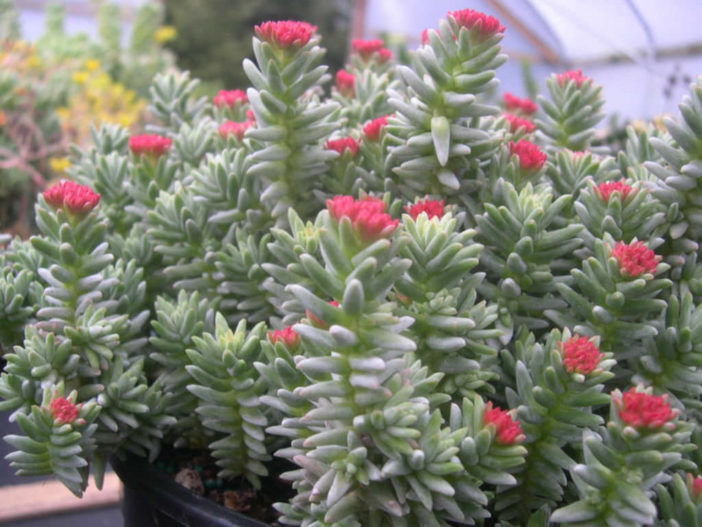Scientific Name
Sedum booleanum B.L. Turner
Scientific Classification
Family: Crassulaceae
Subfamily: Sempervivoideae
Tribe: Sedeae
Genus: Sedum
Description
Sedum booleanum is a bushy succulent with light blue-green overlapping leaves usually stacked in 4 straight rows on upright stems. It grows up to 6 inches (15 cm) tall and up to 10 inches (25 cm) wide. Leaves are thick, fleshy, ovate, up to 0.4 inches (1 cm) long and about 0.15 inches (0.4 cm) wide, gradually becoming smaller towards the stem tips and soon deciduous near the base of stems.
The bright red flowers are unique for a Sedum and appear in terminal clusters in early summer.
Origin
Sedum booleanum is native to Mexico (Nuevo Leon). It grows on gypsum hillsides at elevations of about 4,400 feet (1,340 m).

Hardiness
USDA hardiness zones 10a to 11b: from 30 °F (−1.1 °C) to 50 °F (+10 °C).
How to Grow and Care
When growing Sedums, keep in mind that these plants need very little attention or care. They will thrive in conditions many other plants thrive in but do just as well in less hospitable areas. They are ideal for that part of your yard that gets too much sun or too little water to grow anything else. A common name for Sedum is Stonecrop because many gardeners joke that only stones need less care and live longer.
Sedum is easily planted. For shorter varieties, simply laying the plant on the ground where you want it to grow is usually enough to get the plant started there. They will send out roots from wherever the stem touches the ground and root itself. If you would like to ensure further that the plant will start there, you can add a very thin covering of soil over the plant.
You can break off one of the stems for taller varieties and push it into the ground where you want to grow it. The stem will root very easily, and a new plant will be established in a season or two.
See more at How to Grow and Care for Sedum.
Links
- Back to genus Sedum
- Succupedia: Browse succulents by Scientific Name, Common Name, Genus, Family, USDA Hardiness Zone, Origin, or cacti by Genus
Photo Gallery
Click on a photo to see a larger version.



